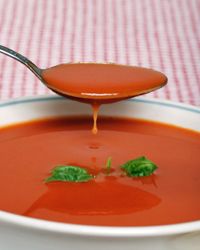Here are some ways to deal with thin sauce:
Leave it on the back burner. Most tomato purists advocate giving a watery sauce a little more time on the stove (sans pot lid, of course). Letting tomato sauce thicken by evaporating the excess liquid has some added advantages. The longer tomato sauce cooks, the more complex, smooth and flavorful it becomes. If your sauces have tasted brassy or almost metallic in the past, another hour on the stove could make this year's batch thick enough to coat the back of your ladle and give it some deep flavor notes you'll love. Why not finish it off in a low oven? You won't have to worry about burning the bottom of the pot, and you can spend the next hour doing something more entertaining than watching molten tomatoes bubbling. You can always employ your trusty crock pot, too.
Add a thickener. Artificial thickeners and tomatoes are often at odds with one another. Starches don't hold up well to the acid in tomatoes. Cornstarch, potato starch and some flours can alter the flavor of tomato-based sauces, create lumps or break down over time. If you do add flour, arrowroot or cornstarch, mix it into a little cold water first, and use the tomato sauce right away.
Don't do anything. Thin isn't necessarily bad, and if you plan on using your homemade sauce in stew, soup or chili, the other ingredients will thicken the sauce for you. Lightly mashed potatoes in a stew or mashed beans in chili will add body to your sauce and blend perfectly with the other flavors in the recipe.




